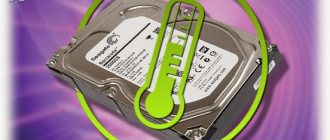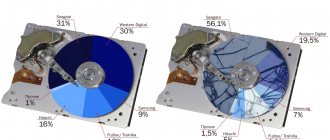When working with disk subsystems, IT specialists often face two main problems.
- The first is the low read/write speed; sometimes even the speeds of an SSD disk are not enough.
- The second is the failure of disks, which means loss of data, the recovery of which may be impossible.
Both of these problems are solved using RAID technology (redundant array of independent disks) - a virtual data storage technology that combines several physical disks into one logical element.
Depending on the selected RAID specification, read/write speeds and/or data loss protection may be improved.
The RAID specification levels are: 1,2,3,4,5,6,0. In addition, there are combinations: 01,10,50,05,60,06. In this article we will look at the most common types of RAID Arrays. But first let's say that there are hardware and software RAID arrays.
Hardware and software RAID arrays
- Software arrays are created after the installation of the Operating System using software products and utilities, which is the main disadvantage of such disk arrays.
- Hardware RAIDs create a disk array before installing the Operating System and do not depend on it.
Obviously, it is recommended to use hardware RAID. Let's move on to consider the main types of RAID arrays.
RAID 1
RAID 1 (also called "Mirror" - Mirror) involves complete duplication of data from one physical disk to another.
The disadvantages of RAID 1 include the fact that you get half the disk space. Those. If you use TWO 250 GB disks, the system will see only ONE 250 GB in size. This type of RAID does not provide a gain in speed, but it significantly increases the level of fault tolerance, because if one disk fails, there is always a complete copy of it. Recording and erasing from disks occurs simultaneously. If information was intentionally deleted, then there will be no way to restore it from another disk.
RAID 0
RAID 0 (also called Striping) involves dividing information into blocks and simultaneously writing different blocks to different disks.
This technology increases the read/write speed, allows the user to use the full total capacity of the disks, but reduces fault tolerance, or rather reduces it to zero. So, if one of the disks fails, it will be almost impossible to restore information. To build RAID 0, it is recommended to use only highly reliable disks.
RAID 5
RAID 5 can be called a more advanced RAID 0 . You can use up to 3 hard drives. Raid 0 is recorded on all but one, and a special checksum is recorded on the last one, which allows you to save information on the hard drives in the event of the “death” of one of them (but not more than one). The operating speed of such an array is high. It will take a lot of time to restore information if the disk is replaced.
RAID 2, 3, 4
These are methods of distributed storage of information using disks allocated for parity codes . They differ from each other only in block sizes. In practice, they are practically not used due to the need to devote a large share of disk capacity to storing ECC and/or parity codes, as well as due to low performance.
RAID 10
It is a mix of RAID arrays 1 and 0. And it combines the advantages of each: high performance and high fault tolerance.
The array must contain an even number of disks (minimum 4) and is the most reliable option for storing information. The disadvantage is the high cost of the disk array: the effective capacity will be half of the total capacity of the disk space.
RAID 50
It is a mix of RAID arrays 5 and 0 . RAID 5 is being built, but its components will not be independent hard drives, but RAID 0 arrays.
How to create a RAID array
Creating a RAID disk array can be done in several ways, using both HDD and SSD in its structure (preferably not simultaneously). Here I would immediately like to make a reservation that it is more expedient to create raids from hard drives rather than solid-state drives. By itself, an SSD already provides high performance and does not create such problems as as part of an array: difficulties in updating the firmware, difficult monitoring of performance, drives wear out evenly, which is why there is a possibility of their simultaneous failure. Therefore, in home use, it is better to work with an SSD as a separate drive in AHCI mode. RAID from an SSD can be useful in some cases, most likely for corporate purposes, where reading a large amount of data is necessary.
Now, let's look at how to combine disks into a RAID array. This requires a special controller, which can be either a physical adapter or in the form of a utility. In accordance with this, the following methods of creating raids are distinguished:
- Fully hardware , where the RAID controller is a separate device with its own software.
- Semi-hardware , when the controller is built into the motherboard. In this case, the hardware RAID array is configured through the BIOS.
- Software , when the creation of arrays occurs through the Linux mdadm utilities or Windows spanned volumes.
We can talk for a long time about the advantages and disadvantages of one or another method. For example, on the Internet you can find a lot of criticism regarding creating raids programmatically, since it is believed that the system will spend a large amount of resources to ensure the operation of the utility. Judging by our experience, this can only be true for raids from SSDs, and from ordinary hard drives, a more or less modern computer will cope with the task. Integrating a RAID controller into a board carries greater risks, in our opinion. There is a possibility of the motherboard failing, setting up and managing the array is difficult, etc. The completely hardware method is reliable and widely used, but the most financially expensive. In addition to purchasing several HDDs, you will have to spend an average of 25 to 60 thousand rubles on an adapter.
You may also be interested in: ways to create home network storage.
For additional information on the topic, watch our special video, where you can start a discussion in the comments and ask all your questions:
If you read this article to the end, then you are probably interested in creating a RAID array on your home computer or office. Our team has extensive experience in system administration and computer maintenance. We can easily provide similar services in St. Petersburg to both individuals and legal entities.
Practical advice
As a rule, disks for setting up RAID are purchased in one batch. Accordingly, their working life may be approximately the same. In this case, it is recommended to immediately, at the time of purchasing disks for the array, purchase some excess. For example, to configure RAID 10 of 4 disks, you should buy 5 disks. So, if one of them fails, you can quickly replace it with a new one before other disks fail.
RAID 1 (mirroring - “mirroring”)
an array of two disks that are complete copies of each other. Not to be confused with RAID 1+0, RAID 0+1, and RAID 10 arrays, which use more than two drives and more complex mirroring mechanisms.
Provides acceptable write speed and gains in read speed when parallelizing queries.
It has high reliability - it works as long as at least one disk in the array is functioning. The probability of failure of two disks at once is equal to the product of the probabilities of failure of each disk, i.e. significantly lower than the probability of failure of an individual disk. In practice, if one of the disks fails, immediate action should be taken to restore redundancy. To do this, it is recommended to use hot spare disks with any RAID level (except zero).
RAID 1
conclusions
In practice, most often only three types of RAID arrays are used. These are RAID 1, RAID 10 and RAID 5.
In terms of cost/performance/fault tolerance, it is recommended to use:
- RAID 1 (mirroring) to form a disk subsystem for user operating systems.
- RAID 10 for data with high write and read speed requirements. For example, for storing 1C:Enterprise databases, mail server, AD.
- RAID 5 is used to store file data.
The ideal server solution, according to most system administrators, is a server with six disks. The two disks are “mirrored” and the operating system is installed on RAID 1. The four remaining drives are combined into RAID 10 for fast, trouble-free, reliable system operation.
RAID 00
RAID 00 is very rare; I came across it on LSI controllers. A RAID 00 disk group is a composite disk group that creates a striped set of a series of RAID 0 disk arrays. RAID 00 does not provide data redundancy, but along with RAID 0, offers the best performance of any RAID level. RAID 00 breaks data into smaller segments and then stripes the data segments on each drive in the storage group. The size of each data segment is determined by the stripe size. RAID 00 offers high throughput. RAID level 00 is not fault tolerant. If a disk in a RAID 0 disk group fails, the entire virtual disk (all disks associated with the virtual disk) will fail. By breaking a large file into smaller segments, the RAID controller can use both SAS controllers to read or write the file faster. RAID 00 does not assume parity; calculations complicate write operations. This makes RAID 00 ideal for applications that require high throughput but do not require fault tolerance. Can consist of from 2 to 256 disks.
How to create an array of hard drives on a computer using a RAID controller?
Before we can build this system, we need to know if the motherboard supports Raid disk arrays. Many modern motherboards already have a built-in Raid controller, which allows you to combine hard drives. Supported array circuits are available in the descriptions for the motherboard. For example, let’s take the first ASRock P45R2000-WiFi board that caught my eye in Yandex Market.
Here, a description of the supported Raid arrays is displayed in the "Sata Disk Controllers" section.
In this example, we see that the Sata controller supports the creation of Raid arrays: 0, 1, 5, 10. What do these numbers mean? This is a designation for various types of arrays in which disks interact with each other according to different schemes, which are designed, as I already said, to either speed up their operation or increase reliability against data loss.
If the computer motherboard does not support Raid, then you can purchase a separate Raid controller in the form of a PCI card, which is inserted into the PCI slot on the motherboard and gives it the ability to create arrays of disks. For the controller to work after installing it, you will also need to install the raid driver, which either comes on the disk with this model, or can simply be downloaded from the Internet. It is best not to skimp on this device and buy from some well-known manufacturer, for example Asus, and with Intel chipsets.
I suspect that you still don’t have a good idea of what we’re talking about, so let’s take a closer look at each of the most popular types of Raid arrays to make everything clearer.
RAID 5
Its operating principle is very similar to RAID 1. Only now you will need at least 3 drives, one of which will store duplicated information. In this case, you will have access to almost the entire volume in the system, except for one disk with data for recovery. In addition, performance will also increase, but not several times as in the case of RAID 0. The main difference between RAID 5 and RAID 10 is the level of reliability and available volume. This array is designed for more specific tasks, when a huge number of disks are assembled together.
Let's say you have 4 disks of 2 TB each. RAID 10 will give you a volume equal to 4 TB, 2 times the speed and the ability to completely restore information in the event of failure of two main media at once. RAID 5 in this case will provide 6 TB for your needs, slightly increased data writing speed and the ability to recover data from only one damaged hard drive. In this case, RAID 10 looks like a more attractive system than RAID 5, because for a 2 TB fee we get high performance and the ability to fully recover.
- Repair
How to repair a faulty hard drive and find the cause of errors
But the situation changes when there are significantly more disks. As we said, RAID 5 is a specific structure. If you have 10 drives of 2 TB each, then RAID 10 will only give you 10 TB available to you. In the case of RAID 5, this is already 18 TB (all disks are available except one, which stores duplicate data). There is already 50% of the available volume - too high a price for the possibility of full recovery and double speed. It is much more profitable to get slightly increased speed, almost full capacity and the ability to restore any one disk. For the common man, such systems are not needed.
Advantages
Does not require much space for recovery Slightly increases performance
Flaws
Not intended for home use Provides incomplete data backup The speed increase is not as great as RAID 10
There are other types of arrays, but they are all too narrowly focused and not suitable for the average user. The schemes described above are used in 90% of cases.
RAID 4
Data is written in blocks to different disks, one disk is used to store parity bits. The difference from RAID 3 is that blocks are divided not into bits and bytes, but into sectors. The benefits include high transfer speeds when working with large files. The speed of working with a large number of read requests is also high. Among the shortcomings, we can note those inherited from RAID 3 - an imbalance in the speed of read/write operations and the existence of conditions that make parallel access to data difficult.
Consider "RAID-0":
More than one HDD disk is combined into one via a serial connection, after which the volumes are summed up, i.e. - if we take several HDD drives, each of which has a capacity of “500GB” and create “RAID-0” from them, then the operating system will perceive the installed HDD drives as one, summing them up, from which we will get one HDD drive with a capacity of 1000Gb (1Tb) . After the disks are merged into one array, the read and write speed of the drive will be twice as fast as that of separate disks.
Example
– a database located on two physical HDD disks, one of which the user will only read data, while the other user will write data to another HDD disk, and they will do all this simultaneously. But if the database is located on only one disk, the HDD disk itself will perform the function of reading or writing for completely different users sequentially by its software. A RAID-0 array will provide the ability to read and write in parallel. Based on the speed, we can conclude - how many HDD disks are in your RAID-0 array, multiply the Ito number by the existing speed (at that speed your RAID-0 will work faster) - the entire dependence of the array is proportional - the speed of HDD claims increases N times, where N = number of installed HDDs in the array.
The RAID-0 array has only one drawback, this minus outweighs everything, even the advantages of its use - the RAID-0 array lacks fault tolerance. The problem is this: if one of the physical HDDs installed in the array fails, then the entire array dies. There is an old joke about this: “What does the “0” mean in RAID-0? — the amount of information that is restored after the death of the array!” (though it’s not fun at all if there’s something very important there).
Next is the “RAID-60” array:
The same principle: in fact, it is “RAID-6”, assembled from several “RAID-0” arrays. There are other combinations of arrays, such as “RAID 5+1 / RAID 6+1” - in fact, they are similar to “RAID-50 / RAID-60” with the difference that the base of their array elements is not “RAID- 0" like others, and the array mirrors are "RAID-1".











